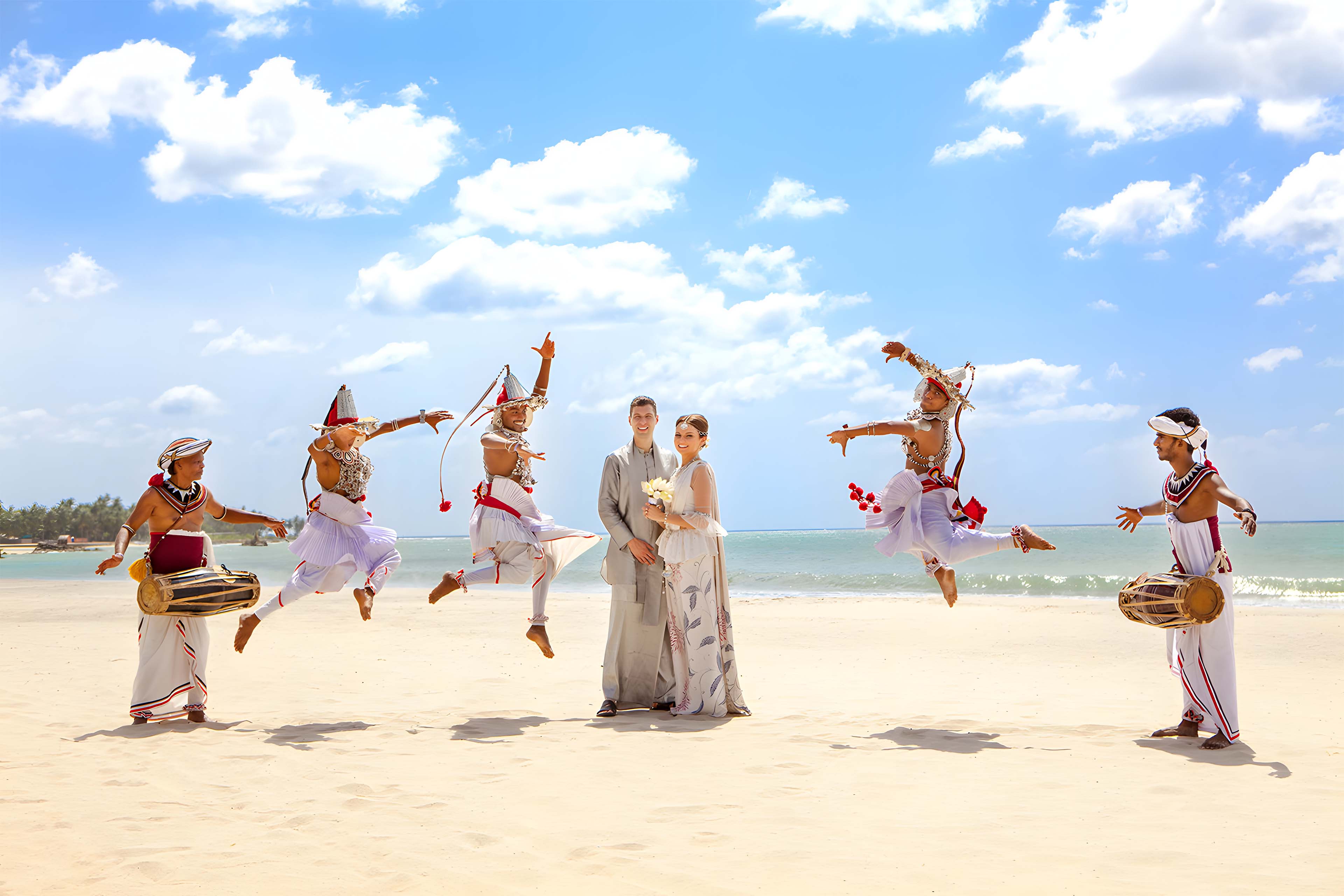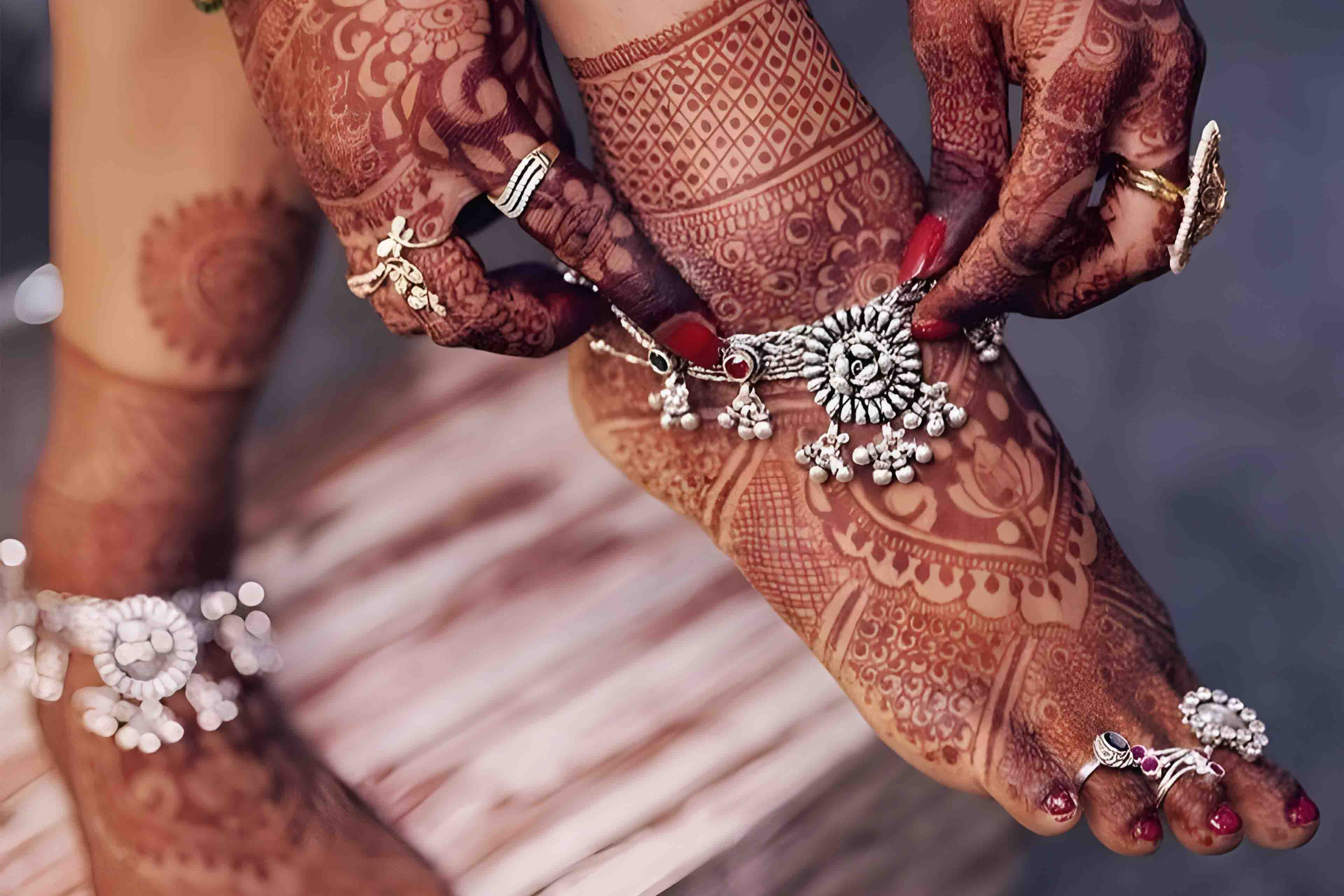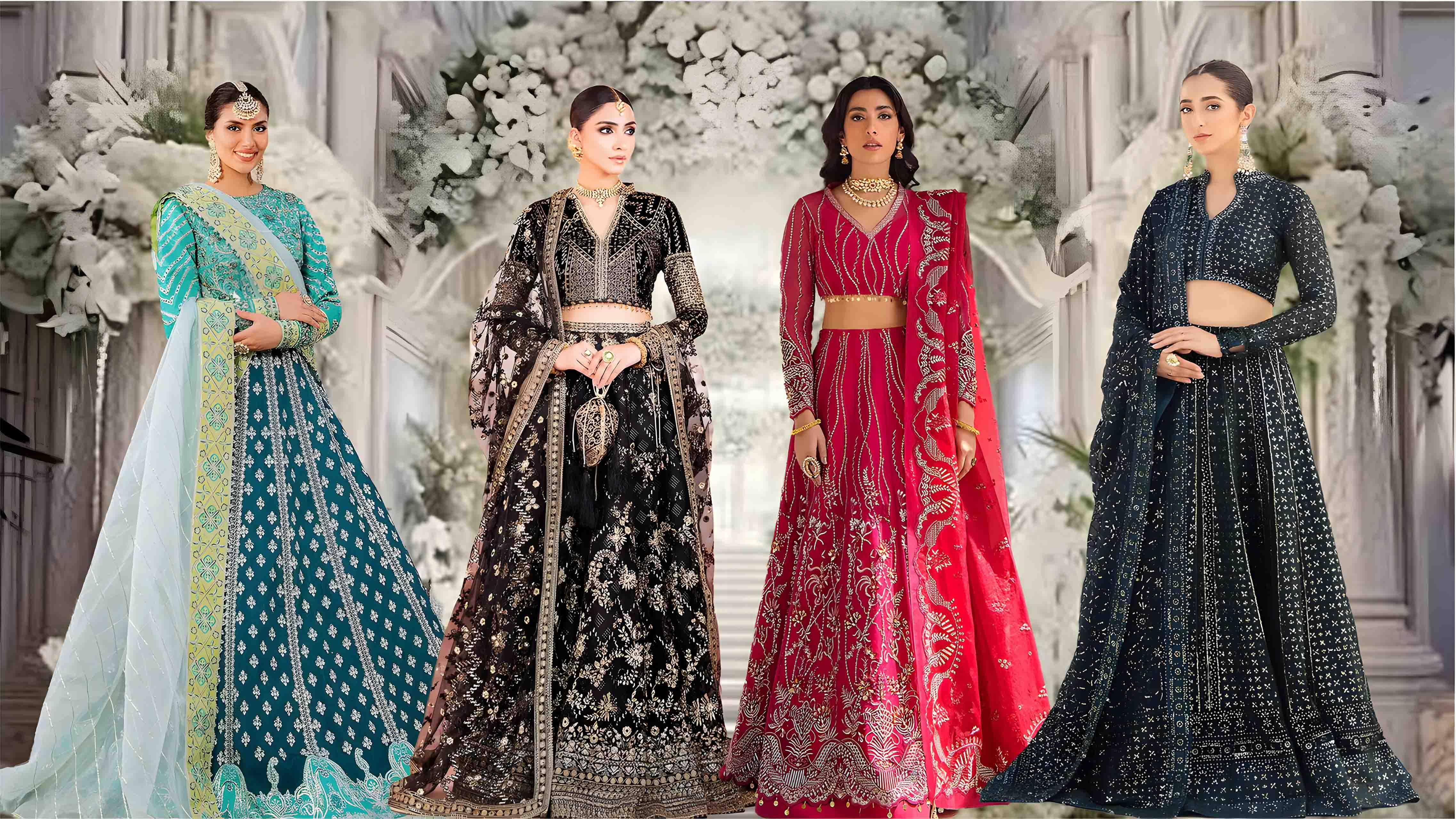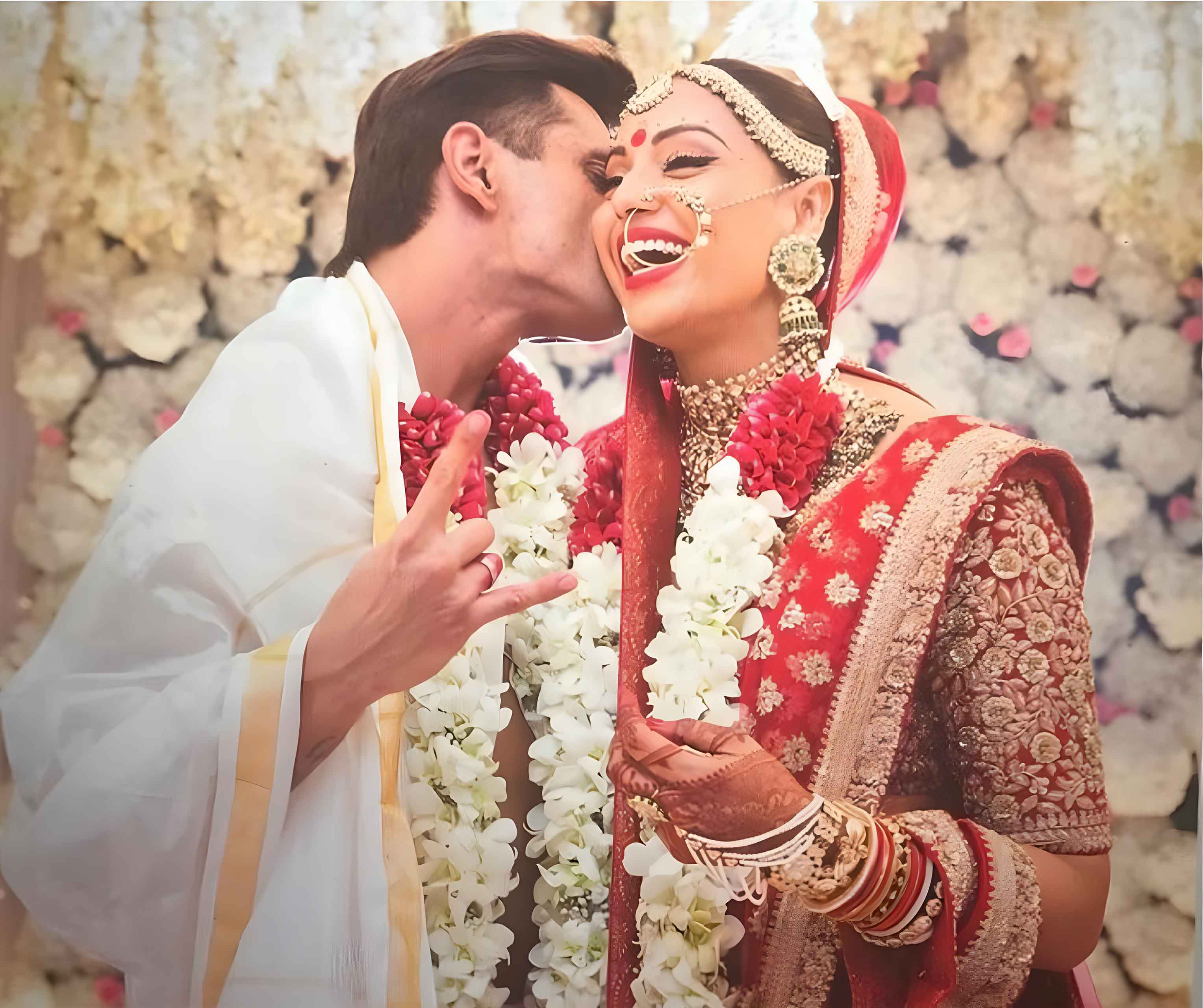Sindoor & Celebrations: Your Comprehensive Guide to the Modern Nepali Wedding
Curious about Nepali weddings? Whether you're planning one, attending one, or just vibing with the culture, this is your modern guide to traditions, trends & etiquette.

last updated: June 9th, 2025 | 9-minute read
Let’s get this out of the way: Nepali weddings are not just Indian weddings with a Himalayan filter. Yes, we love a good Bollywood sangeet and a perfectly winged liner moment—but Nepal brings its own flavor to the wedding table (and no, it’s not just momos... though, obviously, there will be momos).
So if you’ve been doom-scrolling wedding blogs that treat South Asia like one big, colorful lump of turmeric, you’re in the right place. This guide isn’t going to throw you a paragraph about "Hindu customs" and call it a day. We’re diving into what makes Nepali weddings uniquely Nepali—across religions, castes, regions, languages and even zip codes (yes, the Bay Area version of a Janti hits different).
Whether you’re a confused guest, a Nepali-American bride trying to translate tradition for your partner’s side, or just someone who's marrying into the culture and wondering why there's a secret wedding before the actual wedding (hi, Bail Bibaha)—I got you.
And if you’re the kind of person who likes context (or chaos), you might also want to peep the Indian wedding guide, the Pakistani wedding guide, the Bengali wedding guide, or the Sri Lankan wedding guide while you’re at it. South Asia isn’t a monolith—and Laali isn’t here for lazy generalizations either.
So grab a snack, maybe text your cousin for that one wedding photo you forgot to ask about, and let’s unpack what really goes down in a modern Nepali wedding—without the Sanskrit lecture.
Chapter One: Before the Baraat—The Pre-Wedding Lineup
Every South Asian wedding has its pregame rituals, but Nepali weddings? They take it up a notch with a fruit wedding, mustard oil massages, and a whole lot of “wait, what’s happening now?” If you’re in the bridal party (or just nosey and observant), here’s what to expect before anyone even walks down the aisle.

Bail Bibaha — AKA “Marrying a Fruit”
Sounds like a viral TikTok challenge, but it’s actually a deeply rooted Newar tradition. Unmarried girls “marry” a bael fruit—symbol of the god Vishnu—before puberty. Why? Because it ensures they’re *technically* already married, meaning they won’t be considered widows later in life if their future husband dies. It’s both poetic and protective, with a side of citrus.
Karmuka Puja — Your Vedic Energy Cleanse
This is your Vedic energy cleanse before all the big stuff begins—kind of like astrology meets ancestor appreciation. And then there’s Graha Shanti, a planetary peace-keeping ritual (for the stars, not your relatives—those stay messy). Both usually involve lots of rice, flowers, ghee, and the priest talking faster than your Duolingo streak can handle.
Mehendi Nights — Same Formula but Niche Format
Yep, they exist in Nepali weddings too—and they’re getting bigger by the year. Think glowing fairy lights, choreographed cousin dances, aunties hyping up the bride, and that one cousin who starts applying mehendi and suddenly thinks she’s a pro. (Spoiler: she’s not.)
Other regional or family customs may include binayat or pithi-style turmeric paste ceremonies, where mustard oil, rice and haldi are rubbed on the bride and groom—because glowing skin and chaos go hand in hand.
Oh—and outfit planning starts here. Some brides do a lehenga, some do a saree, some wear both. Your aunt will have opinions either way. Just make sure you can dance in it, and that it survives a turmeric ambush.
Chapter Two: The Main Event — Wedding Day Rituals & Processions
Okay, deep breath. It’s the big day—which in Nepali culture means layers of symbolism, spiritual rituals, flower garlands, and that magical combo of sacred fire and mild logistical panic. The vibe? Less red carpet, more red sindoor… but don’t worry, we’ll walk you through it.

The Janti — Baraat, but Make It Nepali
The Janti is the groom’s wedding procession, and yes, it’s giving fanfare. In Nepal, you’d hear the panche baja (a traditional five-piece folk band) leading the way. In the U.S.? It might be a dhol + DJ fusion situation, with the occasional confused neighbor and a drone overhead. Think suits and daura suruwals, flower malas, and that one cousin who takes “dancing in the street” a little too literally. Don’t expect a white horse—but do expect your Apple Watch to hit 10,000 steps before the ceremony even starts.
Swayamvara — Where It All Begins
Forget The Bachelor. This is the real swayamvara—where the bride and groom first lock eyes and *officially* start the ceremony. The couple sits before a sacred fire (because no South Asian wedding is complete without open flames), and the officiant kicks off the wedding rites. Symbolic items like a kalash (water pot), diyo (oil lamp), and kusha ring (made of sacred grass) are part of the setup, and you’ll definitely see some uncle trying to explain what they all mean—incorrectly.
Sindoor Daan — The Red Line of Commitment
This is the moment. The groom applies sindoor (vermilion powder) into the bride’s hair parting, symbolizing her new status as a married woman. It’s intimate, emotional, and—yes—a little awkward if the groom’s hand shakes. Some brides choose to modernize this, either sharing the gesture back or adapting it into a more symbolic offering. Either way, the sindoor moment is sacred, and Laali recommends waterproof makeup.
Kanyadaan — A Hand Over, With Complications
Kanyadaan—literally “giving the bride”—is one of the most traditional and controversial parts of the ceremony. The bride’s parents place her hand in the groom’s, symbolically transferring responsibility. Some modern families are adapting or skipping this entirely (because your daughter is not property), while others keep the gesture but reframe its meaning. Either way, it’s your wedding—do what aligns with your values, not your nani’s friend’s opinion.
Ceremonial Staples — Mala, Tika & Tilhari
The exchange of the dubo ko mala (a garland made of sacred grass) is a sign of mutual respect and devotion. You’ll also see a lot of tika-tala—red and yellow powder pressed to foreheads for blessing—and jewelry like the tilhari (green pote necklace with gold) which holds deep significance for Hindu brides. If you’re not Nepali and getting married into the culture, be prepared for lots of accessories… and even more opinions about how you wear them.
Chapter Three: Post-Wedding Events — Parties, Teary Goodbyes & More Food
If you thought the wedding day was the grand finale, welcome to Act II—where emotions run high, relatives linger longer than expected, and there’s somehow still more food. Nepali post-wedding events are all about ritual, reflection, and one last excuse to wear something fabulous (or at least wrinkle-free).
Bidai — The Big Cry
Also known as vidaai, this is the official send-off of the bride from her parental home. There’s usually tears, rice throwing, some aunt whispering “don’t cry too much, it’ll ruin your makeup,” and the bride trying to hug ten people at once without tripping over her saree.
Ghar Bhitrauni — The Grand Entrance
Once the bride arrives at the groom’s home (or wherever the new fam resides), we get the ghar bhitrauni ceremony. Think flower petals, blessings, maybe a kalash at the door and the classic “kick the rice pot with your foot” moment. It’s part ritual, part Instagram content, part awkward meet-and-greet with people she now has to call auntie and uncle forever.
Mukh Herne — The Official Meet-Cute (But for In-Laws)
Mukh Herne literally means “to show the face.” After the bride is settled, her new relatives come over to see her, give her blessings, and yes—shower her with gifts. This is the perfect time for subtle flexes: makeup that’s still holding up, jewelry that’s inherited (or just looks like it), and your ability to remember names in 0.3 seconds.
Bhui Fekne — The Chaos You Didn’t See Coming
This one varies by region and family, but in some traditions, bhui fekne involves the groom tossing things on the ground as symbolic offerings—sometimes puffed rice, sometimes more metaphorical stuff like “his single life.” Interpret it how you will, but it’s the moment where the energy goes from solemn to slightly unhinged. It’s giving “what even is happening”—but in the best way.

The Reception — Glam, Gossip & TikTok Dances
Finally, the Nepali wedding reception: part victory lap, part dance floor therapy. Expect speeches (some heartfelt, some long-winded), mangal dhun playing during entrances, and that one cousin who drops a surprise TikTok dance that somehow involves sunglasses and dramatic finger pointing. Outfits get trendier here—sarees in bold jewel tones, Indo-Western suits, lehengas that say “I survived five outfit changes and I’m still standing.”
Still with me? We’re just getting started. Post-wedding events are where tradition and freestyle merge—kind of like the cha-cha slide after a puja. Coming up next: Chapter 4, where we dig into the diversity across Nepali weddings (yes, there’s more than one type).
Chapter Four: Diversity, Faith, Fusion & the 1,001 Ways to Be Nepali
Let’s kill the myth real quick: there’s no such thing as one Nepali wedding. If you came here expecting a tidy, one-size-fits-all checklist, you might want to sit down. Nepal is wildly diverse—ethnically, religiously, regionally—and that shows up loudly in its wedding traditions. It’s not all Ganesha and gold bangles (though yes, you’ll still spot both).
Hindu, Buddhist & Kirat Weddings — Not a Copy-Paste Situation
Hindu weddings in Nepal might look similar to those in India but come with their own local twists (see: dubo ko mala and sindoor daan). Buddhist weddings, often practiced by Sherpa or Tamang communities, can involve monks, sacred chants, and simpler symbolic gestures rather than fire rituals. Then there’s Kirat weddings—a lesser-known indigenous tradition practiced by the Rai and Limbu communities—which often centers on mundhum chants and the symbolic exchange of millet beer or animal offerings. Each has its own rhythm, and no, one isn’t “more real” than the other.
Pahadi Wedding vs Madhesi Wedding
Glad you asked. Pahadi weddings (from Nepal’s hilly and mountainous regions) often involve rituals like sindoor daan, mukh herne, and ghar bhitrauni. Madhesi weddings (from the southern Terai region, bordering India) may include different regional music, folk traditions, and more Indo-Gangetic style celebrations—think louder baraats, ornate bridalwear, and rituals with Bhojpuri or Maithili roots. Neither is “fancier,” but yes, both have strong opinions about mithai.

Mixed-Culture Weddings — Nepali + Whatever You’re Bringing
Whether it’s Nepali + Black, Nepali + White, Nepali + Korean (hi, Seoul-meets-Kathmandu Pinterest boards)—blended weddings are on the rise. The trick? Balance. Scripting a ceremony that honors both sides of the family without feeling like a UN summit is an art. Some couples do two ceremonies. Some do one, with bilingual vows and a shared tika moment. As long as both cultures feel seen—and nobody’s grandma is left confused or insulted—you’re winning.
Who wears what? Totally up for discussion. Some brides rock a traditional red Nepali saree for the main event, then change into something from their partner’s culture for the reception. Some skip the costume changes and go fusion chic all the way. The same goes for rituals—chunni ceremony? Maybe. Tea ceremony? Possibly. Cha-cha slide? Inevitable.
Immigrant Adaptations — Coming to America (With Slight Modifications)
Let’s be real: once your wedding crosses the Pacific, some rituals evolve… or vanish entirely. Maybe there’s no buffalo sacrifice at your Texas reception (RIP, grandma’s expectations). Maybe the ashirvad ceremony happens over Zoom. Or maybe the groom’s cousins keep asking why the tilhari looks like green beads from Michaels. All valid. We’ll unpack more of these U.S.-based rewrites in Chapter 6, but know this:
So whether your wedding is held in Kathmandu, Queens or somewhere in between, there’s no wrong way to do “Nepali” as long as it’s done with love, context and maybe a little Laali-approved flair.
Chapter Five: So You’re the Guest — Etiquette, Experience & Expectations
Congrats! You’ve been invited to a Nepali wedding. Whether you're a cousin, a co-worker, or the plus-one who’s just here for the food, this is your survival guide. Because while Nepali hospitality is elite, that doesn’t mean you shouldn’t come prepared. Here’s what you need to know to show up (and show out) without causing cultural confusion.
What to Wear — Slay Respectfully
Here’s your wardrobe cheat sheet: saree or lehenga if you want to blend in with the Desi auntie squad, kurta set for comfort and class, or a dressy Western outfit if you’re new to the culture—just keep it modest and skip the white. (No one’s mourning here.) Avoid upstaging the bride and maybe don’t wear fire-engine red unless you’ve checked what she’s wearing first. This is a wedding, not your fashion week debut.
What to Bring — Gifts, Cash, Vibes
Traditionally, cash in an envelope is the safest and most appreciated gift—bonus points if you add a note. Some families might register for gifts, but unless you see a link, assume cash is king. No, Venmo doesn’t count (yet). Also: snacks, because that three-hour ceremony is going to test your blood sugar levels and your patience.
What *Not* to Do — Faux Pas You Can Totally Avoid
- Don’t interrupt a tika ceremony. If you see red powder and quiet chanting, that’s your cue to stand back and observe. You’re not the main character here.
- Don’t assume the bride will wear red—but don’t be shocked if she does. Yes, it’s still the power color in Nepali weddings, but modern brides are doing blush, gold, even teal. Let her live.
- Do bring cash for gifts, not vibes or hugs. (Repeat after me: envelopes over emojis.)
- Do expect dancing—even if the stage looks suspiciously calm. At some point, someone’s uncle will lose it to an 80s Nepali song or Bollywood remix. Be ready. Don't fight it.
Bottom line? Be respectful, be ready to dance, and don’t block the auntie with the DSLR. She takes her job very seriously.
Chapter Six: Aesthetics, Chaos & Pure Vibe — Modern Trends and Adaptations
If you made it this far, you already know Nepali weddings aren’t just one-size-fits-all—they’re everything everywhere all at once. But beyond the rituals and auntie drama, let’s talk about what’s trending. Because while tradition holds it down, modern Nepali weddings (especially in the U.S.) are all about fusion, flair and full-blown personal expression. It’s not just a ceremony—it’s a vibe.
Fashion Forward — Sarees, Sherwanis & The Hybrids
Gone are the days when brides were boxed into heavy zardozi lehengas and nothing else. Now? We’re seeing minimalist sarees with sleek drapes, fusion bridal sets that mix cultures and comfort, and grooms pulling up in velvet sherwanis or even three-piece suits with Nepali accents. There’s also a rising tribe of daura suruwal + Jordans combos (yes, really)—and honestly, we’re not mad about it.
Decor Dreams — Mandaps, Mountainscapes & Flower Fever
If it looks like a Pinterest board exploded but make it spiritual, you’re in the right place. From floral mandaps to ceremony backdrops inspired by the Himalayas (because yes, someone always brings up Everest), decor is getting bold, botanical and deeply personalized. One couple even did a DIY mandap made of prayer flags and pine branches in Colorado. That’s called vision.
Foodie Moments — Momos and Beyond
Let’s be real: food makes the wedding. And while buffets still reign supreme, more couples are opting for curated momo stations (pan-fried, steamed, vegan—don’t fight us), thali-style appetizers that give you a bite of everything, and even chai carts rolling out with spiced brews at midnight. Laali tip? Always end with sikarni if it's on the menu. You’ll thank us later.
Party Mode — DJs, Saxophones & Slight Mayhem
The DJ is still the MVP, but Nepali weddings are leveling up with live bands, emcees who actually pronounce names right, and yes, that one uncle with a saxophone who always steals the show. Choreographed cousin dances? Mandatory. Bollywood playlists? Expected. Your one introvert cousin suddenly performing a full medley with props? Icon behavior.
If you made it all the way here—hi, you’re my kind of reader. The kind who wants the vibes and the verified info. So let’s land this Himalayan plane with a quick recap and a wink.
Nepali weddings? They’re layered, vibrant, emotional, chaotic, and yes—stunning. From bael fruit engagements to sindoor commitments to post-wedding TikTok choreo, every tradition carries meaning (even if that meaning is “why are we rubbing mustard oil on each other at 8AM?”).
They’re also not monolithic. Whether you're watching a Buddhist monk chant over butter lamps or cheering on a hybrid ceremony with two languages and three outfit changes, know this: there’s no one right way to do a Nepali wedding.
What matters most? That it feels like you. That your community feels seen. And that at least one person cries happy tears when the tika hits just right.
And if all you took away from this is “no white, yes snacks, wear waterproof mascara”—you’re already ahead of the game.
xoxo,
Laali Ladki
FAQ: You Asked, Laali Answered
Short answer: not short. Most Nepali weddings last anywhere from 3 to 7 days, depending on the region, religion, and how extra your family is. That includes pre-wedding rituals (like Bail Bibaha), the main wedding day, and post-wedding events like Bidai and Ghar Bhitrauni. In the U.S., though, many couples condense things into a long weekend of vibes and logistics.
We’ve got a whole chapter on this, but if you’re skimming: look out for the Janti (the groom’s procession), Swayamvara (where it all begins), Sindoor Daan (the red powder moment), and Kanyadaan (a handoff that’s… evolving). You’ll also see dubo ko mala garlands, tilhari necklaces, and tika blessings everywhere. Basically, if there’s a priest and a fire, something important is happening.
Sometimes, but it’s not always part of the traditional lineup. Instead of diamonds, you might see a kusha ring—a sacred grass loop symbolizing purity and unity. That said, many modern couples in the U.S. are blending traditions, so yes, the bling is definitely showing up more.
That’s called tika—a mix of red vermilion and sometimes rice or yogurt, applied during blessings. It shows respect, protection, and, depending on the setting, a lot of family hierarchy. If someone’s applying it to you, smile and accept it. Don’t flinch—it's not blood, it’s tradition.
Color, not cleavage. If you’re South Asian, bring out the lehengas, sarees, or kurtas. Non-Desi? Dressy conservative works too—long skirts, festive dresses, embroidered jackets. Avoid white (it’s a mourning color), and don’t show up in red unless you’ve checked what the bride’s wearing. Chapter Five has you covered if you’re still panicking.
Yes—and the gift is cash. Physical gifts are rare unless requested. Most families expect an envelope of money (even more common at post-wedding events like Mukh Herne). If you’re unsure how much, think wedding registry budget range—but in rupee conversion mode.
Nope. No kiss-cam moment here. Most Nepali weddings—especially the traditional ones—are spiritual, not steamy. There might be emotional glances and hand-holding, but keep your PDA PG-13 until the reception dance floor kicks in.
Oh, we love this one. While there are overlaps (shared deities, some similar rituals), Nepali weddings come with distinct traditions like Bail Bibaha, dubo ko mala exchanges, and the use of tilhari jewelry. Even the vibe is different—less Bollywood, more ancestral roots-meets-modern remix. Plus, Nepal’s ethnic diversity means there’s no single blueprint.
There’s no official “bridesmaid” role in traditional ceremonies, but modern U.S.-based Nepali weddings have definitely adopted them. Duties may include organizing mehendi nights, helping with outfit changes, and shielding the bride from 27 aunties giving conflicting advice. Think less flower girl, more event manager.
Right here, boo. Laali has a curated vendor list including Nepali-friendly photographers, decorators, planners and stylists who know the difference between a tilhari and a party prop. No need to settle for generic “Desi” listings—find your people, your way.
Featured
Desi Weddings
Find Culturally Capable Vendors
You’re not just having a wedding, you’re having a South Asian wedding. From hosting multiple events to incorporating ancient traditions, there’s a lot that will make your wedding unique. With Laali, you can find vendors who get it and have experience making South Asian weddings spectacular!
Connect With Us





Comments (3)
Anonymous
03 Sep 2025
Plunge into the epic galaxy of EVE Online. Shape your destiny today. Trade alongside hundreds of thousands of explorers worldwide. [url=https://www.eveonline.com/signup?invc=46758c20-63e3-4816-aa0e-f91cff26ade4]Join now[/url]
Anonymous
17 Sep 2025
Laali [url=http://www.g280lgvw57946j120mr5x38eocb4v0pgs.org/]uoslrwfpdpr[/url] oslrwfpdpr http://www.g280lgvw57946j120mr5x38eocb4v0pgs.org/ <a href="http://www.g280lgvw57946j120mr5x38eocb4v0pgs.org/">aoslrwfpdpr</a>
Anonymous
25 Sep 2025
Laali [url=http://www.ge403g97r1avt3c48x2o4y7e2s4wdn56s.org/]uqirhycjhv[/url] qirhycjhv http://www.ge403g97r1avt3c48x2o4y7e2s4wdn56s.org/ <a href="http://www.ge403g97r1avt3c48x2o4y7e2s4wdn56s.org/">aqirhycjhv</a>